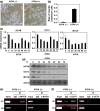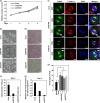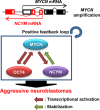Functional interplay between MYCN, NCYM, and OCT4 promotes aggressiveness of human neuroblastomas
- PMID: 25880909
- PMCID: PMC4520635
- DOI: 10.1111/cas.12677
Functional interplay between MYCN, NCYM, and OCT4 promotes aggressiveness of human neuroblastomas
Abstract
Neuroblastoma is a pediatric solid tumor that originates from embryonic neural crest cells. The MYCN gene locus is frequently amplified in unfavorable neuroblastomas, and the gene product promotes the progression of neuroblastomas. However, the molecular mechanisms by which MYCN amplification contributes to stem cell-like states of neuroblastoma remain elusive. In this study, we show that MYCN and its cis-antisense gene, NCYM, form a positive feedback loop with OCT4, a core regulatory gene maintaining a multipotent state of neural stem cells. We previously reported that NCYM is co-amplified with the MYCN gene in primary human neuroblastomas and that the gene product promotes aggressiveness of neuroblastoma by stabilization of MYCN. In 36 MYCN-amplified primary human neuroblastomas, OCT4 mRNA expression was associated with unfavorable prognosis and was correlated with that of NCYM. The OCT4 protein induced both NCYM and MYCN in human neuroblastoma cells, whereas NCYM stabilized MYCN to induce OCT4 and stem cell-related genes, including NANOG, SOX2, and LIN28. In sharp contrast to MYCN, enforced expression of c-MYC did not enhance OCT4 expression in human neuroblastoma cells. All-trans retinoic acid treatment reduced MYCN, NCYM, and OCT4 expression, accompanied by the decreased amount of OCT4 recruited onto the intron 1 region of MYCN. Knockdown of NCYM or OCT4 inhibited formation of spheres of neuroblastoma cells and promoted asymmetric cell division in MYCN-amplified human neuroblastoma cells. These results suggest that the functional interplay between MYCN, NCYM, and OCT4 contributes to aggressiveness of MYCN-amplified human neuroblastomas.
Keywords: MYCN; NCYM; OCT4; neuroblastoma; transcriptional regulation.
© 2015 The Authors. Cancer Science published by Wiley Publishing Asia Pty Ltd on behalf of Japanese Cancer Association.
Figures






Similar articles
-
NCYM, a Cis-antisense gene of MYCN, encodes a de novo evolved protein that inhibits GSK3β resulting in the stabilization of MYCN in human neuroblastomas.PLoS Genet. 2014 Jan;10(1):e1003996. doi: 10.1371/journal.pgen.1003996. Epub 2014 Jan 2. PLoS Genet. 2014. PMID: 24391509 Free PMC article.
-
NCYM promotes calpain-mediated Myc-nick production in human MYCN-amplified neuroblastoma cells.Biochem Biophys Res Commun. 2015 Jun 5;461(3):501-6. doi: 10.1016/j.bbrc.2015.04.050. Epub 2015 Apr 17. Biochem Biophys Res Commun. 2015. PMID: 25896758
-
TAp63 represses transcription of MYCN/NCYM gene and its high levels of expression are associated with favorable outcome in neuroblastoma.Biochem Biophys Res Commun. 2019 Oct 15;518(2):311-318. doi: 10.1016/j.bbrc.2019.08.052. Epub 2019 Aug 17. Biochem Biophys Res Commun. 2019. PMID: 31427086
-
De novo evolved gene product NCYM in the pathogenesis and clinical outcome of human neuroblastomas and other cancers.Jpn J Clin Oncol. 2020 Aug 4;50(8):839-846. doi: 10.1093/jjco/hyaa097. Jpn J Clin Oncol. 2020. PMID: 32577751 Review.
-
The MYCN oncoprotein as a drug development target.Cancer Lett. 2003 Jul 18;197(1-2):125-30. doi: 10.1016/s0304-3835(03)00096-x. Cancer Lett. 2003. PMID: 12880971 Review.
Cited by
-
Evaluating the RIST Molecular-Targeted Regimen in a Three-Dimensional Neuroblastoma Spheroid Cell Culture Model.Cancers (Basel). 2023 Mar 14;15(6):1749. doi: 10.3390/cancers15061749. Cancers (Basel). 2023. PMID: 36980635 Free PMC article.
-
PHF20 collaborates with PARP1 to promote stemness and aggressiveness of neuroblastoma cells through activation of SOX2 and OCT4.J Mol Cell Biol. 2018 Apr 1;10(2):147-160. doi: 10.1093/jmcb/mjy007. J Mol Cell Biol. 2018. PMID: 29452418 Free PMC article.
-
Mechanisms involved in selecting and maintaining neuroblastoma cancer stem cell populations, and perspectives for therapeutic targeting.World J Stem Cells. 2021 Jul 26;13(7):685-736. doi: 10.4252/wjsc.v13.i7.685. World J Stem Cells. 2021. PMID: 34367474 Free PMC article. Review.
-
The Role of MYCN in Symmetric vs. Asymmetric Cell Division of Human Neuroblastoma Cells.Front Oncol. 2020 Oct 21;10:570815. doi: 10.3389/fonc.2020.570815. eCollection 2020. Front Oncol. 2020. PMID: 33194665 Free PMC article. Review.
-
SP1-induced HOXD-AS1 promotes malignant progression of cholangiocarcinoma by regulating miR-520c-3p/MYCN.Aging (Albany NY). 2020 Aug 28;12(16):16304-16325. doi: 10.18632/aging.103660. Epub 2020 Aug 28. Aging (Albany NY). 2020. PMID: 32857725 Free PMC article.
References
Publication types
MeSH terms
Substances
LinkOut - more resources
Full Text Sources
Other Literature Sources
Medical
Research Materials

